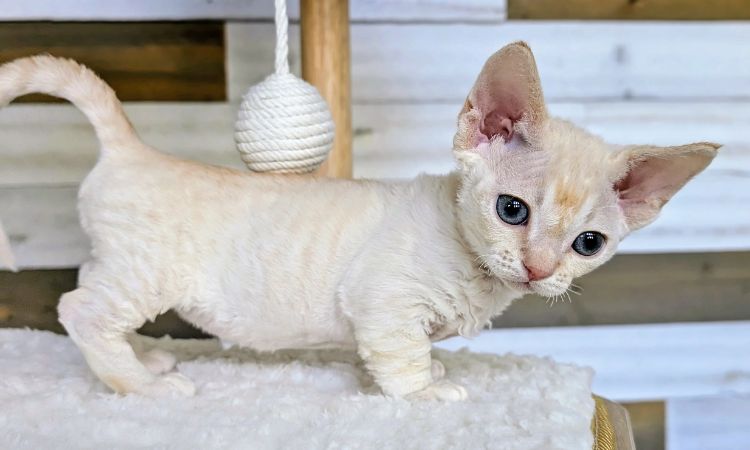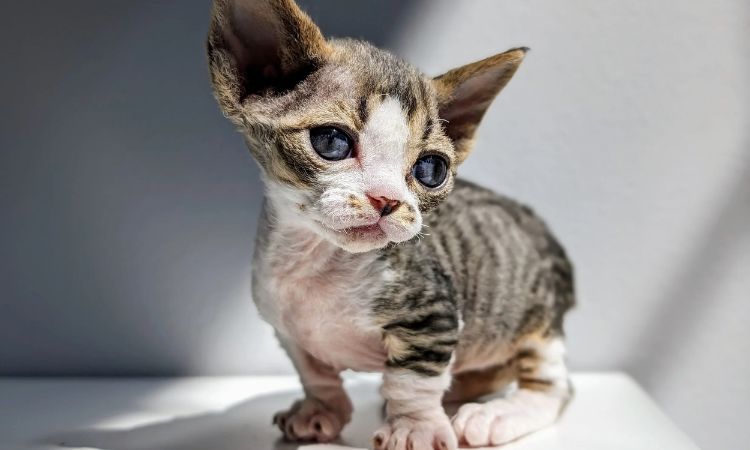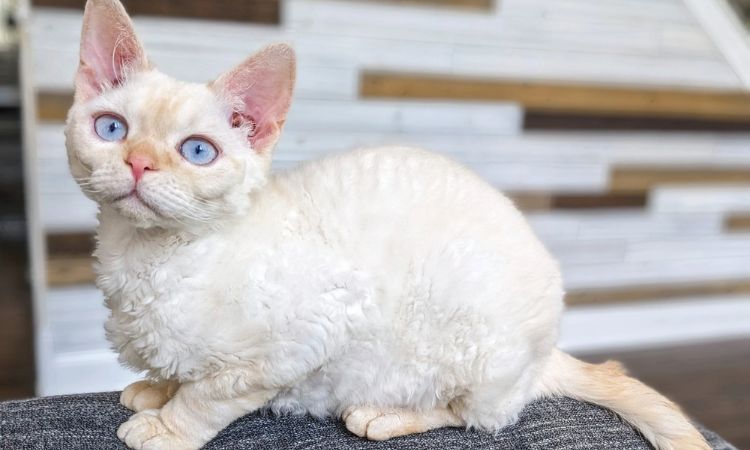If you’re on the hunt for a cat that’s as unique as it is lovable, the Minskin might just be your perfect match. This captivating breed is the result of a carefully planned cross between the Munchkin, Burmese, Sphynx, and Devon Rex bringing together the best of short legs, sleek coats, and playful personalities.
Curious about what makes the Minskin so special? Keep reading as we dive into everything you need to know, from its price and hypoallergenic status to five essential facts before you bring one of these delightful kitties into your home.
Introduction to the Minskin Breed
The Minskin is a distinctive and fascinating breed, known for its small size, short legs, and sparse, rexed coat. With a unique blend of physical traits from several breeds, the Minskin has captured the attention of cat lovers around the world. Despite its mostly hairless appearance, the breed retains patches of fur on its extremities, such as the ears, legs, and tail, giving it a distinctive “fur points” pattern reminiscent of the Siamese. This breed’s playful, affectionate nature, combined with its exotic looks, makes it an appealing choice for those seeking a low-maintenance companion.
The Minskin’s ancestry traces back to a careful cross-breeding of four distinct breeds: the Munchkin, Sphynx, Devon Rex, and Burmese. Each of these breeds contributed unique characteristics—Munchkin’s short legs, Sphynx’s hairlessness, Devon Rex’s rexed coat, and the Burmese’s affectionate temperament. This mix of traits gives the Minskin its unmistakable appearance and endearing personality.

The breed was first developed in Boston by Paul McSorley in 1998, who sought to create a cat with the short legs of the Munchkin, combined with a unique coat pattern like that of the Siamese. By the early 2000s, McSorley had successfully bred the first Minskin cat that met his desired standards. The breed is still in its developmental stages and is actively monitored by The International Cat Association (TICA), which recognized it as a Preliminary New Breed in 2008. However, as of now, Minskins are still quite rare, with only a small number of breeders working to advance and preserve the breed.
As the Minskin continues to develop, it remains a rarity, and those seeking to add one to their family should be prepared to join a waitlist with a reputable breeder. The breed’s unique look and charming personality ensure that it remains one of the most intriguing and sought-after modern cat breeds today.
Minskin Cat Price Range: What to Budget
Breeder Costs for a Rare Minskin Kitten
Because the Minskin is still a developing and very rare breed, prices for kittens tend to be significantly higher than more common cat breeds.
Estimated Price Range: $1,500 – $4,000+ per kitten
Factors that affect the cost include:
- Show Quality vs. Pet Quality: Kittens bred for show standards or exceptional appearance can cost considerably more than a standard pet-quality kitten.
- Pedigree: Minskins with well-documented lineage from reputable breeders often command higher prices.
- Coat Features: The unique fur-points pattern (dense fur on extremities with sparse body hair) can influence pricing, as certain patterns or colors may be rarer.
Because of their designer status, it’s crucial to buy from an ethical breeder who prioritizes health and temperament over profit.
Ongoing and Lifetime Expenses
Owning a Minskin cat involves more than just the purchase price. Here’s what to budget for long-term care:
Initial Setup Costs: $500 – $1,000
- Cat carrier: $20–$50
- Cat bed: $20–$50
- Toys and enrichment: $10–$50
- Litter box and litter: $20–$50
- Grooming supplies (anti-fungal shampoo, brushes): $15–$50
Monthly Costs: $70 – $150 (varies by lifestyle and health care)
- Food: $30–$70, ideally high-protein, vet-approved cat food.
- Vet care & insurance: $25–$100 for routine check-ups, flea/tick preventatives, and pet insurance. Pet insurance specifically for rare breeds may run $30–$50/month.
- Environment maintenance: $5–$20 for litter, cleaning supplies, or cat tree upkeep.
- Entertainment: $10–$25 for new toys or subscription boxes to keep an active Minskin engaged.
Health Considerations: Because Minskins inherit traits from Munchkins and Sphynx, they may require additional care for conditions like lordosis, osteoarthritis, or skin sensitivities. Setting aside funds for unforeseen medical expenses is strongly recommended.

Is the Minskin Cat Hypoallergenic? Addressing the Myth
Despite their sparse, rexed coat and partially hairless appearance, Minskin cats are not hypoallergenic. The misconception likely arises from their minimal shedding and soft, downy fur, which makes them look low-maintenance. However, the primary allergen responsible for cat allergies is Fel d 1, a protein found in a cat’s saliva, skin oils, and dander, not their fur length.
Even with less hair to shed, close contact with a Minskin can trigger allergy symptoms such as itchy eyes, sneezing, runny nose, and skin irritation. Hairless areas may actually increase direct exposure to allergens. Regular grooming, wiping down the cat’s skin, and maintaining a clean environment can help reduce allergen exposure, but they do not eliminate the risk entirely.
For allergy sufferers seeking a cat with minimal triggers, consider alternative breeds known for lower Fel d 1 production, such as the Devon Rex, Sphynx, Balinese, or Russian Blue.
5 Essential Things to Know Before Bringing Home a Minskin
Fact 1: Appearance—Short Legs and “Fur Points”
Minskin cats are instantly recognizable thanks to their distinctive short legs, a result of chondrodysplasia, the same genetic trait seen in Munchkin cats. Their body is small and cobby, giving them a perpetually kitten-like appearance. Unlike fully furred breeds, Minskins have a sparse, downy coat covering most of their body, while denser patches of fur—known as “fur points”—appear on the mask, ears, legs, and tail. These contrasting points create the breed’s signature look and contribute to its exotic charm.
Fact 2: Dog-Like Temperament: Social and Affectionate
One of the Minskin’s most endearing traits is its playful, intelligent, and highly social nature. They form strong bonds with their human companions, often following them from room to room and seeking interactive play. Their affectionate demeanor makes them excellent family pets, as they usually get along well with children and can coexist peacefully with other cats and even dogs. This outgoing personality makes the Minskin more than just visually striking—it’s a genuinely engaging companion.
Fact 3: Unique Grooming Needs (Bathing, Not Brushing)
Thanks to their ultra-fine coat, Minskins do not require traditional brushing like other cats. Instead, regular bathing—typically every 1 to 3 weeks—is essential to remove excess skin oils and prevent skin infections or irritations. The “fur points” may benefit from occasional gentle brushing to keep them soft and tidy, but overall, their grooming routine is simple yet critical. Daily checks of ears, teeth, and skin will ensure a healthy, comfortable cat.

Fact 4: Indoor Living and Temperature Sensitivity
Minskins are indoor-only cats due to their minimal protective fur. They are particularly sensitive to cold and will actively seek warmth, whether curling up on a lap, nestling under blankets, or wearing a soft sweater during chilly months. Conversely, their sparse coat provides little defense against sunlight, making them prone to sunburn if exposed directly. For sunbathing near windows, it’s recommended to apply pet-safe sunscreen to keep their delicate skin safe.
Fact 5: Potential Health Concerns from Parent Breeds
While generally healthy, Minskins inherit certain genetic traits from their parent breeds that may predispose them to specific conditions. The short-leg mutation (chondrodysplasia) can increase the risk of joint problems such as osteoarthritis, while spinal conditions like lordosis or pectus excavatum may occasionally occur. Choosing a reputable breeder who screens for these issues is crucial to minimizing health risks and ensuring a long, happy life for your Minskin.
Minskin cats are rare, affectionate, and playful pets with unique care needs. Understanding their grooming, indoor requirements, health risks, and cost ensures you can provide a safe and loving home. Being informed helps you make a responsible choice before bringing a Minskin into your family.






